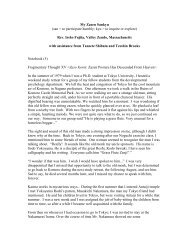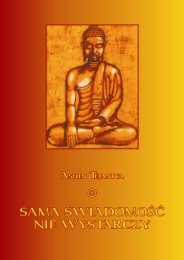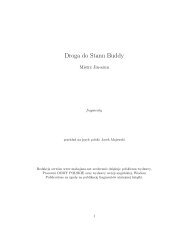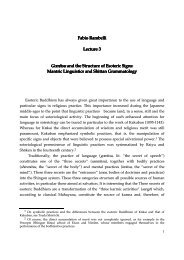Mahamudra Teaching - Dharma Media
Mahamudra Teaching - Dharma Media
Mahamudra Teaching - Dharma Media
Create successful ePaper yourself
Turn your PDF publications into a flip-book with our unique Google optimized e-Paper software.
<strong>Mahamudra</strong> itself, just as soon as a negative thought arises, at that very moment, by the power of<br />
<strong>Mahamudra</strong>, negative thoughts are vanquished. <strong>Mahamudra</strong> just suddenly kind of destroys or<br />
uproots the negative thoughts. Through that we can manifest activities to others to also demolish the<br />
delusions of others. So that is what is called fire ceremony.<br />
So therefore, in a nutshell, all of these practices are included in the mind. This is how our mind can<br />
stand right where it is, how the mind can be sovereign over the whole world or the entire universe<br />
through the meditation of <strong>Mahamudra</strong> and thereby achieve all the excellent qualities.<br />
We can go deeper into the meaning of the mandala meditations. The idea of the mandala is that it is<br />
like the whole globe or like a country or like a family and that the principal deity is like the leader of<br />
the country who at the center rules the entire country. Globally speaking, the United Nations kind of<br />
takes care of the world internationally. Or, more locally, in the family, anyone who is more powerful<br />
in the family rules that family. It is that kind of idea, which is built into the mandala. For example, in<br />
practicing Chenrezig, the great deity of compassion, whether of the 1000-armed or 4-armed form, we<br />
visualize that the whole universe is Chenrezig’s mandala and that Chenrezig is at the center<br />
surrounded by the four Buddhas.<br />
We meditate with the sense that the entire universe is outside. Actually it is all contained within our<br />
body. Our body includes the five afflictive emotions. The negative thoughts of the body are the five<br />
Buddhas, the five skandhas are the five female Buddhas, the eight consciousnesses are the eight<br />
Bodhisattvas and the eight objects of the eight consciousnesses are the eight female Bodhisattvas.<br />
They have that nature. It is not literally that. But the nature of these is the five Buddhas and eight<br />
Bodhisattvas. Or sometimes we say six afflictive emotions. The six afflictive emotions are the six<br />
Buddhas in the six realms, which are within our body. Then in the mandala we build 1002 Buddhas.<br />
When there are any of these, for example, the five Buddhas, the eight Bodhisattvas, or the six<br />
Buddhas, or the five female Buddhas or the eight female Bodhisattvas, each individual one has<br />
significance. They each have meaning with respect to the transformation and purification of our own<br />
thoughts and the duality, which we are subject to.<br />
All of these kinds of thoughts are to benefit all sentient beings. Within the mandala there are four<br />
gates with one in each of the four directions. These four gates symbolize the four activities: the<br />
peaceful activities, the power activities, the increasing activities, and the wrathful activities. So each<br />
and every one of these activities can be utilized to purify our own negative thoughts as well as to<br />
benefit all sentient beings.<br />
One may briefly look inside our mind with respect to how to use these four activities to purify our<br />
delusions. Through the “peaceful” means we are gentle to ourselves and to our thoughts. We uplift<br />
ourselves, bring joy, and in that kind of way peacefully purify negative thoughts. And then there<br />
arise some other kind of negative thoughts, which have a little more strength. They are kind of going<br />
here or there, you need a little more power to control then. Wisdom will transform your thoughts.<br />
When we utilize this “power” activity to purify our thoughts, then that quality itself “increases”<br />
activities to purify all the delusions, negative thoughts. And in the case of the “wrathful” activities or<br />
insights, sometimes our mind is so arrogant that it enslaves you. At that time use the power of the<br />
wisdom to directly penetrate its nature and destroy that. So we have to use these four activities to<br />
purify our inner negative thoughts.



![Shushogi, Dogen Zenji [PDF] - Mahajana.net](https://img.yumpu.com/50921105/1/190x219/shushogi-dogen-zenji-pdf-mahajananet.jpg?quality=85)


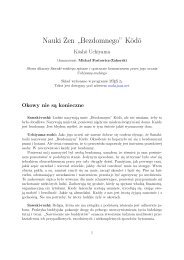

![wywiadu z Murakami Kosho Roshim [PDF] - Buddyzm w Polsce i na ...](https://img.yumpu.com/45809746/1/184x260/wywiadu-z-murakami-kosho-roshim-pdf-buddyzm-w-polsce-i-na-.jpg?quality=85)



